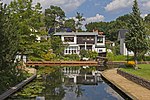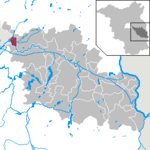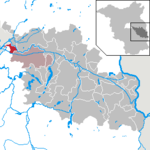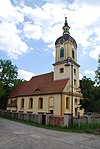Tabor Church (Berlin-Wilhelmshagen)
20th-century Lutheran churches in GermanyArt Nouveau architecture in BerlinArt Nouveau church buildings in GermanyBuildings and structures in Treptow-KöpenickChurches completed in 1911 ... and 3 more
Heritage sites in BerlinInfobox religious building with unknown affiliationUnited Protestant church buildings in Berlin

Tabor Church (Wilhelmshagen) (German: Tabor-Kirche) is one of the three churches of the Evangelical Berlin-Rahnsdorf Congregation, a member of today's Protestant umbrella organisation Evangelical Church of Berlin-Brandenburg-Silesian Upper Lusatia. The church building is located in the quarter Wilhelmshagen, locality Rahnsdorf, borough Treptow-Köpenick of Berlin. The church was named in memory of the Transfiguration of Jesus, which allegedly took place on Mount Tabor הר תבור in today's Israel.
Excerpt from the Wikipedia article Tabor Church (Berlin-Wilhelmshagen) (License: CC BY-SA 3.0, Authors, Images).Tabor Church (Berlin-Wilhelmshagen)
Schönblicker Straße, Berlin Rahnsdorf
Geographical coordinates (GPS) Address Phone number Website Nearby Places Show on map
Geographical coordinates (GPS)
| Latitude | Longitude |
|---|---|
| N 52.43517 ° | E 13.715036 ° |
Address
Taborkirche
Schönblicker Straße
12589 Berlin, Rahnsdorf
Germany
Open on Google Maps











